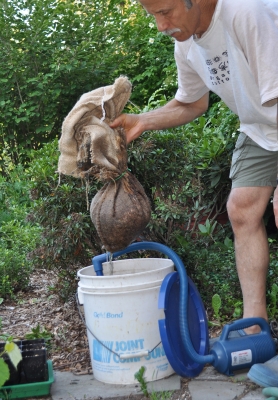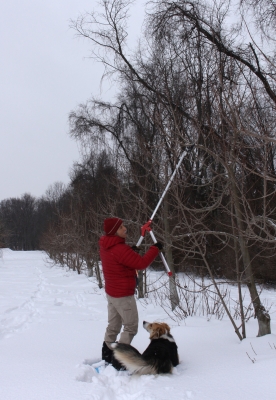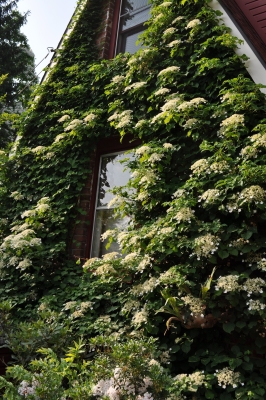FRUIT BOOK GIVEAWAY, AND FRUIT FUTURES
/53 Comments/in Books, Fruit, Gardening, Pests, Vegetables/by Lee ReichThe Eternal (Fruit) Optimist
We fruit growers get especially excited this time of year. On the one hand, there’s the anticipation of the upcoming season. And on the other hand, we don’t want to rush things along at all.
Ideally, late winter segues into the middle of spring with gradually warming days and nights. Unfortunately, here, as in most of continental U.S., temperatures fluctuate wildly this time of year. Warm weather accelerates development of flower buds and flowers. While early blossoms are a welcome sight after winter’s achromatic landscapes, late frosts can snuff them out. Except for with everbearing strawberries, figs, and a couple of other fruits that bloom more than once each season, we fruit lovers get only one shot at a successful crop each season.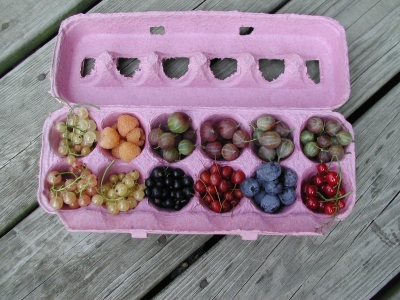
How did all these fruits ever survive in the wild? They did so by not growing here — in the wild. Apples, peaches, cherries — most of our familiar fruits — were never wild here, but come from climates with more equable temperatures, mostly eastern Europe and western Asia. We favor them because they are part of our mostly European heritage.
The fruits that I never worry about here are the few that are native: pawpaw, persimmon, grape, mulberry, lingonberry, and blueberry, to name a few. (Also raspberry, gooseberry, and currants, cultivated varieties of which are hybrids of native and European species.) After decades of fruit growing, I’ve hardly missed a harvest, no matter what the weather, from any of these native fruits. (I cover native, non-native, common, and uncommon fruits in my books Uncommon Fruits for Every Garden and Grow Fruit Naturally.)
 Still, I can’t deny the delicious flavor of apples, peaches, and other non-native fruits, especially those I grow myself. So I do grow them, do what I can for them, and hope for the best. I may even put a thin coat of white kaolin spray on these trees to reflect the sun’s warmth and further delay awakening of the buds.
Still, I can’t deny the delicious flavor of apples, peaches, and other non-native fruits, especially those I grow myself. So I do grow them, do what I can for them, and hope for the best. I may even put a thin coat of white kaolin spray on these trees to reflect the sun’s warmth and further delay awakening of the buds.
Last year was a very poor year for many tree fruits, and I’m not sure why. (Recovery from the previous years cicada attacks could be part of the reason.) Nonetheless, every year about this time I’m bursting with optimism for a bountiful fruit harvest.
Veggies, As Usual, Chugging Along Nicely
I consider vegetables relatively easy to grow because most are annuals and because, with most of them, I can sow and harvest repeatedly throughout the growing season. Let cold or some pest snuff them out, and I can just replant.
The first of my lettuces, sown early last month in little seed trays, are up and growing strongly, each seedling transplanted into its own APS cell (available from www.gardeners.com). Ninety-six seedlings take up little more than a couple of square feet and, with capillary watering from a reservoir beneath the APS trays, I need check the water only about every week.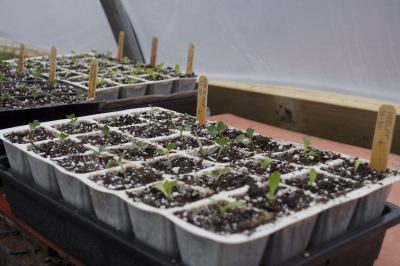
My next wave of indoor seed-sowing will take place in the middle of this month. That’s when I’ll sprinkle pepper, eggplant, broccoli, Brussels sprouts, kale, and cabbage seeds into the miniature furrows of miniature fields of my seed flats.
I’ll also sow another batch of lettuce seeds indoors, this batch for eventual transplanting outdoors. The first batch is soon to be transplanted into greenhouse beds.
Fig Prophylaxis
Buds on fig trees planted in the ground in the greenhouse are showing hints of green and swelling ever so slightly in spite of the cool night temperatures in there. The scale insects that I battled last year are undoubtedly also coming to life on those plants. In the past, I’ve kept these insects at bay by scrubbing the bark in winter with soapy water or by spraying it with insecticidal soap, or, during the growing season, wrapping the trunk with a sticky Tanglefoot barrier to stop travel of ants that herd the insects.
I’ve never gotten rid of scale insects, only kept them from gaining the upper hand. And some years it’s been a neck and neck race as to who would win out before the end of the season.
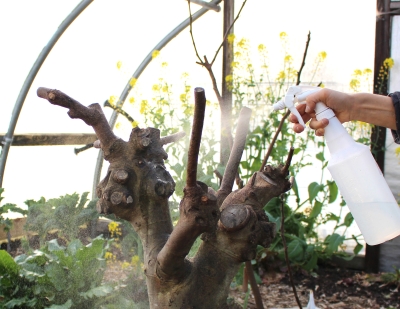 I’ve already begun this season with prophylactic sprays of oil. Oil has a long history of controlling insects and some diseases, with the advantage of causing little collateral damage to the environment, including beneficial insects. Because it’s main effect is to clog insect breathing ports (spiracles), there’s little danger of insects developing resistance.
I’ve already begun this season with prophylactic sprays of oil. Oil has a long history of controlling insects and some diseases, with the advantage of causing little collateral damage to the environment, including beneficial insects. Because it’s main effect is to clog insect breathing ports (spiracles), there’s little danger of insects developing resistance.
Oil’s major hazard is its potential to injure plants, mitigated by spraying when temperatures aren’t too hot or below freezing, or when rain is likely, all easily avoided in a greenhouse. Various kinds and formulations of oil — kinds include vegetable, mineral, and neem oils — differ in their hazard to plants. I’m using a high-purity mineral oil (Sunspray) from which I expect no damage, especially since the plants are still leafless.
Scale insect eggs should be hatching about now. Brutal as it may sound, I hope to suffocate the crawlers before they settle down to one spot to cover themselves with their protective armor and literally suck the life from the plants. Weekly sprays should cover successive hatches.
New Video
Check out my new video on “pricking out” seedlings!
Free Book!
Book giveaway! Write a comment here telling us which is the most difficult fruit you grow, and why, and why you grow it, and you’ll be entered in a drawing to get a free copy of my most recent book Grow Fruit Naturally. Comments must be submitted no later than noon, March 23rd.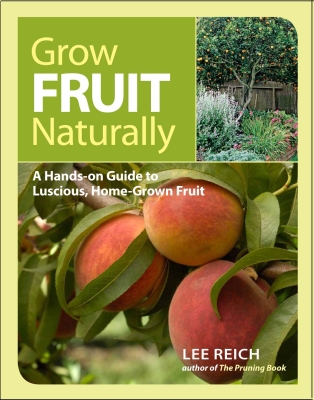
Upcoming Lectures
Check out the “Lectures” page of my website for some lectures I’ll be giving in the next few weeks.
COMPOST TEA: SNAKE OIL OR PLANT ELIXIR?
/26 Comments/in Gardening, Pests, Soil/by Lee ReichIs the Jury Still Out on Compost Tea?
In gardening, as in life, you can’t help but want to love some things, compost tea being one of them. After all, compost is good, tea is soothing, so what’s not to love about compost tea?
Perhaps it depends on how you brew your tea. Traditional compost tea was and is made by hanging a burlap bag of compost in water, then diluting and drenching the ground or the potting mix of a potted plant with the nutritious, coffee-brown liquid.
More recently, “aerated compost tea” (ACT) has soothed gardeners from coast to coast, the result mostly of the promotional efforts of soil scientist Dr. Elaine Ingham. This tea is brewed similarly to the traditional tea, except that extra foods, such as molasses (honey would seem more in keeping with the tea theme), brewers yeast, and bran, are also added, and — most important — the tea is aerated throughout the brewing process.
The soothing effect from ACT is not nutritional, but biological. You spray the tea on leaves or soil to spread beneficial microorganisms leached from the compost whose populations were beefed up by all that aeration and added nutrients. These happy microbes fight off attack by pathogens and insects, perhaps by making the offenders sick or unable to reproduce, perhaps by making the plants more healthy, or any one of a number of other hypothesized manners.
Coming from their home in the dark, moist, nutrient-rich innards of a compost pile, could these friendly microbes really be expected to survive on the bright, dry, nutrient-poor surface of a leaf? And evolutionarily-speaking, when would Mother Nature ever have made provisions for compost, let alone compost tea, let alone ACT microbes, to colonize a leaf and do good there? But this is all speculation; surely someone must have tested whether or not compost tea is really “soothing” to plant life.
How to Really Test Effectiveness
A slew of gardeners and farmers have tried ACT and can attest to its benefits. Matter of fact, a whole industry is dedicated to testing composts and compost teas, even selling compost tea brewers and compost tea itself.
The way to truly ascertain the efficacy of compost tea is to subject it to the same scientific scrutiny as you would anything else: Come up with a hypothesis (such as “Compost tea prevents powdery mildew of squash plants”) and then design an experiment to test the hypothesis. Said experiment would need both treated (compost tea sprayed) and control (water sprayed) plants. Most gardeners and farmers go to the trouble of spraying compost tea because they believe it will be effective, so are not willing to leave a portion of untreated (control) plants. Their endorsements, then, must be taken with a grain of salt, and the same must be said for endorsements from anyone reaping financial gain from compost tea.
One treated and one control plant, even one treated and one control plot of plants, would not be sufficient for a good test. Biological systems are complex. Grow 10 tomato plants under exactly the same conditions and some will grow a little more, some a little less than the others. With too few test plants, natural variations in plant growth might overwhelm variation due to a treatment. With enough plants to even out and offer a measure of natural variations in, say, plant growth, effects of a treatment are better parsed out.
And finally, randomization is needed to even out any effects of, say, location. Perhaps one side of a plot is more windy, or the soil is slightly different, or there’s a bit more sunlight. Rather than have all the treated plants cozied together growing better or worse because of this added effect, even out these effects by randomizing the location of treated and control plants.
Now you’ve got an experiment. Using a few arithmetic formulas or, these days, a computer program, you plug in the numbers and come up with a probability of an effect of the treatment. In agriculture, a 90% or 95% probability is usually considered sufficient. You can then answer “yea” or “nay” to the hypothesized question, in this example, “Does compost tea prevent powdery mildew of squash plants?” with a 90% or 95% confidence level
Okay, I’ll Try It
I have a friend who is a big proponent of compost tea. Finally, he convinced me to give it a try but only after I made him agree to supply me with a brewer, some compost, and explicit instructions, just to avoid his finding excuses for failure of the tea treatment.
A red flag went up when he advised me not to use it in my vegetable garden because it was “too organic.” I ended up, on his suggestion, spraying a few strips down my lawn and parts of some bean rows on a friend’s farms.
This admittedly nonscientific test conclusively showed no benefit at all from the tea.
Snake Oil, Mostly
So what’s the scientific verdict on compost tea? The answer is not so simple, in part because it depends whether the reference is to traditional compost tea or ACT, the kind of plant, the compost ingredients, how long the tea is brewed, how often tea is applied, etc.
Good experiments have been performed, from which the following general conclusions can be made: 1) ACT is not reliably beneficial (and often has a negative effect or spreads human pathogens such as Salmonella); 2) Traditional compost tea has been shown to be often but only mildly beneficial for root diseases; 3) If sufficiently, but not too, dilute, either ACT or traditional compost tea can supply nutrients to feed plants.
My pea plants succumb early every summer to some root disease, possibly fusarium. I am tempted to drench the soil for the peas with traditional compost tea. Perhaps I’ll even set it up as a crude experiment, keeping in the back of my mind the admonition of Charles Dudley Warner (My summer in A Garden, 1871), “I have seen gardens which were all experiment, given over to every new thing, and which produced little or nothing to the owners, except the pleasure of expectation.”
Mostly, though, I’ll continue to do what I’ve been doing, spreading compost on top of the ground and letting rainwater make the tea.
MANURE ABSOLVED, PRUNING STARTED
/12 Comments/in Design, Fruit, Gardening, Pruning, Soil/by Lee ReichHorse Manure: Not Guilty, So On To Pruning
A dark cloud no longer hangs over my horse manure, that is, the horse manure that I occasionally truck over here to add to my compost piles. I wrote a few weeks ago about the possibility of herbicide that, when applied to hay, retains its toxic effect when an animal eats the hay and even, for a long time, after that animal’s manure has been composted or spread on the ground.
My herbicide residue concerns were soothed with a simple assay that showed satisfactory growth from bean seeds in both hay that was suspect and hay of known integrity. Also, the bedding in the horse manure is mostly wood shavings rather than hay.
But another ugly dragon kept raising its head above the manure. Another chemical, this time, Ivermectin, a de-worming medication given to horses (and other animals). Ivermectin or its metabolites might pass through the animal and injure soil dwelling creatures such as beneficial nematodes and earthworms. Past studies have shown negative effects on, for example, “dung fauna and degradation of faeces” (to quote a research paper from 2006).
Ivermectin is, admittedly, a very useful material, even useful in humans to combat lice, bedbugs, and some more frightening tropical afflictions such as river blindness and elephantiasis. Agriculture is always a balancing act, but I like to keep my soil-dwelling partners happy.
So I was gladdened when a veterinarian recently directed me to a Stanford University publication that summarized research findings on the environmental effects of Ivermectin. To whit: Ivermectin is excreted and it can affect earthworms, springtails, and other fauna. But it degrades quickly at summer temperatures (1-2 weeks, but much longer in winter) and within a day or two of exposure to bright sunlight. With temperatures within my compost bins reaching 150°F., or more, with the compost sitting many months before use, and with the compost being spread on top of the ground, little Ivermectin would end up in the soil. And soil anyway naturally has low levels of this compound.
Snow Makes Me Taller
Let’s look aboveground, at stems; there’s pruning to be started. With well over a foot of snow on the ground, I turn my attention to taller plants. The snow is actually an advantage because, with snowshoes on, I can reach more than a foot higher into the branches without a ladder.
For now, I’m going to start with the easiest pruning, mostly with plants that don’t need regular pruning beyond removing dead, diseased, broken, and grossly misplaced branches. Right here, such plants include pawpaws, plums, cornelian cherries, and a teenage honeylocust tree. Light is important for fruit production from the fruit trees and, generally, to keep diseases and insects at bay, so I also prune away enough branches to let remaining branches bathe in sunlight.
I go at the pawpaws with one more goal in mind, to keep fruit from forming either too high in the tree or two far out on the limbs. Pawpaw trees will grow 15 to 25 feet high but I harvest fallen fruit from the ground. By my estimation, fruit can make a soft landing, undamaged, from a height of about 10 feet onto mulched ground. So I lop back the tops to weak side branches at about that height.
Each pawpaw flower is a multiple ovary, potentially spawning up to nine fruits, each of which can weigh more than half a pound. That’s a lot of weight perched onto the end of a branch, so I shorten long branches to decrease leverage of that fruit load.
(More about all types of pruning on all kinds of plants in my book, The Pruning Book.)
A Beautiful Climber
I actually did begin pruning a few weeks ago, before the first snow fall. The plant was hydrangea — no, not the common bigleaf hydrangea which has many people scratching their heads about how to prune, but climbing hydrangea (Hydrangea anomala subsp. petiolaris).
Climbing hydrangea is one of the most beautiful vines, even right now as the peeling, pale cinnamon, bark is in focus among the leafless stems. All summer long, the stems are clothed in lustrous green foliage and, in early, summer clusters of white flowers twinkle against that backdrop like stars in the dark sky.
As expected, the vine took a few years to get firmly established. Now it threatens to engulf my brick home except that I want to restrict it to only the north wall. Every year now, I prune back stems creeping like groping fingers around the east and west walls. And each year the flower stems reach further directly out from the wall, so I also shortened them.
The present pruning doesn’t permanently subdue the plant. This summer, I’ll again shorten the wandering stems, and I’ll be back at it again next winter and for winters to come.

